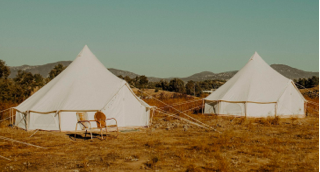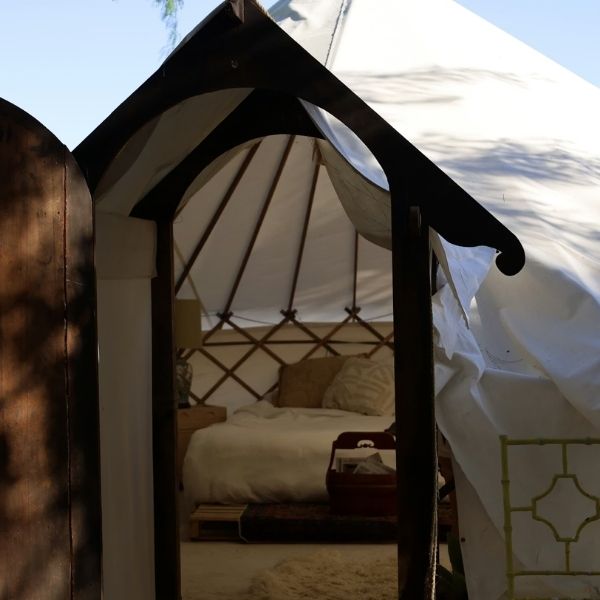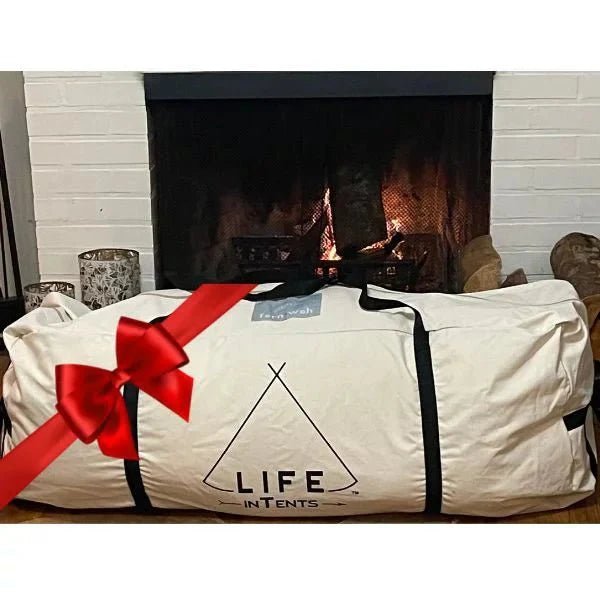Call Us: 1-971-220-8360
Free Shipping

Pay No Sales Tax
30-Month Warranty
Call Us: 1-971-220-8360
Tents
Shop


The LiT List
Glamping & Camping Ideas + Resources
Camping Tent Stove Safety Tips
5 min read
Despite all of our technological developments, humans remain as susceptible to cold temperatures as ever. The right tent stove is a safer alternative to sleeping too close to an open flame. Knowing how to install and use your device safeguards your health and life and that of your family and friends.
What should you know before heading into the wild to keep your tent hot? Here are six tent stove safety tips to keep you toasty and safe at your next chilly camping adventure.

Understand the Risks
While incidental injuries can occur, there are two primary risks associated with camp stove use:
- Carbon monoxide poisoning: This potentially deadly gas is colorless, odorless and tasteless, meaning it can kill while you sleep unless you recognize the warning signs first.
- Risk of tent fire: An improperly installed stove may ignite your tent, potentially trapping you and possibly causing a forest fire.
Incidental injuries include accidental burns from touching, brushing or falling against a hot stove surface or a singe from an escaping spark.
Learn the Signs of Carbon Monoxide Poisoning
As previously mentioned, carbon monoxide is undetectable by humans unless you mindfully tune into the physical symptoms. Pay attention and immediately clear the area if you experience the following:
- Headache
- Weakness
- Dizziness
- Nausea or vomiting
- Shortness of breath
- Confusion
- Blurred vision
- Loss of muscle control
- Loss of consciousness
It’s urgent to get into the fresh air before losing consciousness. Prop the tent flap open if possible as you depart and wait for the fire to burn itself down. From there, you can troubleshoot whether the issue is improper installation or a faulty device. Be sure to set up your tent stove early enough before you bed down for the night to notice potential signs of trouble.
We highly suggest placing a carbon monoxide alarm inside of any tent that is using a wood stove or any type of heater.
Choose the Right Stove for Your Tent — and Vice Versa
Many tent stoves consist of titanium for lightness of weight. It matters when backpacking, as you don’t want to add excess pounds to your back frame. However, it’s equally important to use the right size for the space you intend to heat. Larger stoves burn longer, and you can always start a smaller fire. Therefore, go bigger if torn between two sizes.
Furthermore, it’s equally important to select the right tent. It should have two features: a flame-retardant coating and a protective vent hole for the stove pipe. Usually, cotton or poly-cotton canvas are the best choice for tent material. Many models have additional fire protection around the flue exit point, called a stove jack (these can also be added yourself, along with a flashing kit).

Install Your Stove Correctly
It’s crucial to follow the manufacturer’s directions to a T when installing your tent stove to protect your safety. Avoid the temptation to rig any missing parts. Your best bet is to do a practice run back home before heading into the wild to avoid a lengthy drive back into town.
These tips can make nearly any tent stove installation safer. While they’re included in many manufacturer’s instructions, they merit a special mention here.
-
Use a Spark Arrestor
A spark arrestor is a type of metal grate designed to fit around the top of your stove pipe flue. Its purpose is to prevent stray sparks from traveling up the pipe, landing on your tent or the surrounding foliage and igniting a fire. Although many models include them, add one if yours does not.
-
Use a Flame-Retardant Mat and Tools
If your tent stove doesn’t come with a flame-retardant mat, you must invest in one separately to prevent your device, and hot ash, from burning through the floor of your tent and igniting a blaze. Additionally, a sturdy pair of gloves protect your hands, and tongs let you manipulate logs without scorching your fingers. We have a tent stove kit that includes many of these items.
-
Use a Long Enough Stove Pipe
If your flue pipe doesn’t extend far enough past your tent’s roof, you risk embers igniting it. You should leave at least six inches between the top of the pipe and the hole through which it extends. Plus, make sure to use a triple wall pipe piece where your flue exits and touches your tent to reduce heat at this contact point!
-
Consider a Fly Cover
A fly cover creates an additional layer between your tent’s roof and any escaping sparks. It can prevent burning a hole in your tent and protect against unwanted condensation even when you don’t use your stove, so consider adding it to your kit. Note that you may need to add a stove jack to your fly cover, as many covers don't have these included (are are likely not flame-retardant).
-
Keep Combustibles at a Distance
Avoid storing gasoline and other flammable substances near your tent stove. It’s best to keep them out of your tent altogether, perhaps stowing them in your vehicle.
-
Watch Out for Wildlife
Are you camping in bear country? Avoid the temptation to heat dinner on your tent stove. The aroma of food can linger on the canvas, drawing unwanted guests during the night. Follow campsite directions and use approved containers and fire pits for preparing and storing food.

Keep Water and a Fire Extinguisher on Hand
Even if you follow all safety precautions, accidents can occur anytime you use a device containing open flames. Therefore, keep plenty of water and a fire extinguisher close at hand when operating your tent stove.
Furthermore, ensure you can make a quick escape if a fire breaks out during the night. Position your sleeping bag far enough away from your stove to avoid accidentally bumping it and create a clear path between it and the door. Keep a flashlight by your side (and a sharpe knife) so you can beat a hasty retreat in the dark.
Clean and Maintain Your Stove
Always burn clean wood! Then, you should remove all ash from your tent stove after each use. Additionally, you should clean the stove pipe to remove all creosote, which poses an additional fire hazard — keeping it at bay is a crucial safety tip. You’ll need a special brush and a scraper to remove any stuck-on gunk. While you can buy commercial scrubs, many people swear by a simple solution of baking soda and water to keep their pipes clean.
Tent Stove Safety Tips
A tent stove can significantly increase your comfort when cold-weather camping. It can be a valuable survival tool but can just as quickly turn deadly if you ignore the risk of carbon monoxide poisoning and fire.
Follow these tips to install and operate your tent stove safely. Enjoy happier cold-weather camping excursions with the benefit of a little “modern-primitive” heat. Feel free to add more tips below to help your fellow campers!
Related Resources

THE LIT LIST 4 min read
5 Reasons Yurt Tents Are the Ultimate Backyard Guest House
Hosting overnight guests? Consider a spacious backyard yurt tent as a spare guest room. Since many fHosting for the holidays or inviting overnight guests? Here are 5 reasons why yurt tents create the ultimate backyard guest room for your visiting family and friends. Affordable reason for selecting a yurt style tent for more permanent backyard glamping.

THE LIT LIST 2 min read
Black Friday Through Cyber Week Camping Tent Sales
Are you looking to save some money on purchasing a 2025 camping tent gift for that special someone? Popular Blogs
Camping Gift Ideas for People Who Have Everything
The Best Portable Tent Heaters - Ways To Heat A Canvas Tent
Glamping in Northern California: 8 Luxury Sites
Waterproofing A Canvas Tent - Retreating Canvas
33 Camping Quotes to Inspire Your Next Adventure
What Is Glamping? Origins, Definition, Destinations & More
10 Tips for Staying Warm While Winter Camping
How to Maintain and Clean a Bell Tent
Essential Family Camping Checklist: What to Pack [PRINTABLE]
Backyard Glamping Checklist for an Unforgettable DIY Glampsite
Popular Products
Subscribe
Sign up to get the latest on sales, new releases and tips
BECOME AN INSIDER
We’ll periodically share inspiration, bell tent releases, special offers, and event notifications with ya.



